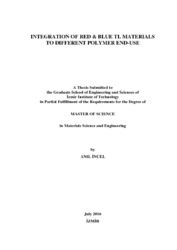Please use this identifier to cite or link to this item:
https://hdl.handle.net/11147/2753Full metadata record
| DC Field | Value | Language |
|---|---|---|
| dc.contributor.advisor | Demir, Mustafa Muammer | - |
| dc.contributor.author | İncel, Anıl | - |
| dc.date.accessioned | 2017-01-11T11:20:45Z | |
| dc.date.available | 2017-01-11T11:20:45Z | |
| dc.date.issued | 2016-07 | - |
| dc.identifier.citation | İncel, A. (2016). Integration of red & blue TL materials to different polymer end-use.Unpublished master's thesis, İzmir Institute of Technology, İzmir, Turkey | en_US |
| dc.identifier.uri | http://hdl.handle.net/11147/2753 | - |
| dc.description | Thesis (Master)--Izmir Institute of Technology, Materials Science and Engineering, Izmir, 2016 | en_US |
| dc.description | Includes bibliographical references (leaves. 50-54) | en_US |
| dc.description | Text in English; Abstract: Turkish and English | en_US |
| dc.description | xii, 54 leaves | en_US |
| dc.description.abstract | Triboluminescence (TL) is known as the emission of light upon the application of any mechanical force. In this master thesis, two organometallic-based TL crystals, which are EuD4TEA and Cu(NCS)(py)2(PPh3) were obtained and they were integrated in the transparent polymers: poly (methylmetacrylate) (PMMA), poly (styrene) (PS), poly (urethane) (PU) and polyvinylidene fluoride (PVDF) for different end-use. In the development of composites, two different processes were carried out: i) embedding (or blending) and ii) surface impregnation. The different end-use polymers were used as transparent polymer film, electrospun nanofibers, and nanobeads. TL performance of composites were investigated by using drop tower system which was specficically designed for this research. Atomic force microscopy (AFM), scanning electron microscopy (SEM) were used to characterize the topographic and morphologic properties of both polymers and composites. Additionally, fluorescence microscopy helped to understand the signal of emitted light by composites. Lastly, piezoelectric properties of composite materials were invetigated by oscilloscope. According to results, type of process, particle size of crystal, surface property and form of host material (polymer), the concentration of crystalline particles in composites were determined as the main parameters and the results were estimated with respect to these parameters. PU-based composite film and fiber show better stability towards mechnical stress rather than PMMA, PS, and PVDF due to the roughness surface of thin-film surface for film-based composites, smallest wickerwork formation of electrospun mats for fiber-based composite, and the chemical affinity of PU with TL crystals. | en_US |
| dc.description.abstract | Tribolüminesans (TL) olarak bilinen kristal yapılar mekanik kuvvet altında ışık emisyonu yapma özelliğine sahiptirler. Bu yüksek lisans tezinde, organik ve metal yapıları bir arada bulunduran iki TL kristal elde edilmiş ve bu parçacıklar PMMA (poli metil metakrilat), PS (poli sitren), PU (poli üretan) ve PVDF (poli vinil florür) transparan özellikteki polimerler kullanılarak ince-katmanlı film, elektrospun fiber ve nano boyutundaki tanecikler elde edilen matrisler ile entegrasyona tabii tutulmuştur. Kompozit malzemelerin elde edilmesi için iki farklı deneysel metot geliştirilmiştir: i) yükleme işlemi ve ii) yüzeye depolama işlemi. Kompozit malzemelerin TL performansları bu tez için özel tasarlanan atış kule sistemi ile analiz edilmiştir. Bunun yanı sıra, atomik kuvvet mikroskobu (AFM), taramalı elektron mikroskobu (SEM) polimerlerin ve kompozit malzemelerin topografik ve morfolojik özellklerini değerlendirmek için kullanılmıştır. Ayrıca, flüoresans mikroskobu kullanılarak kompozit malzemelerin emisyon sırasındaki renk sinyalleri belirlenmiştir. Son olarak piezoelectrik özellikleri osiloskop kullanılarak tamamlanmıştır. Tüm bu cihazlardan elde edilen sonuçlar değerlendirildiğinde, deneysel prosedür, kristal parçacıkların boyutları, polimer malzemenin formu ve yüzey özelliği, kullanılan kristallerin kompozit içindeki miktarı bu çalışmada temel parametreler olarak belirlenmiştir. PU esaslı elde edilen film ve fiber kompozitler PMMA, PS, ve PVDF esaslı kompozitlerden daha iyi sonuç göstermiştir. Bunun nedeni olarak, film esaslı kompozitler için ince katmanlı PU filmin daha engebeli bir yüzey olması; fiber esaslı kompozitler için elektrospun PU fiberin daha küçük yapılardan oluşması, tüm bunlara ek olarak PU’nın kimyasal olarak TL özellikteki iki kristalle kimyasal etkileşim oluşturulması gösterilebilir. | en_US |
| dc.language.iso | en | en_US |
| dc.publisher | Izmir Institute of Technology | en_US |
| dc.rights | info:eu-repo/semantics/openAccess | en_US |
| dc.subject | Polymers | en_US |
| dc.subject | Transparent polymers | en_US |
| dc.subject | Electrospun nanofibers | en_US |
| dc.subject | Composite materials | en_US |
| dc.subject | Triboluminescence (TL) | en_US |
| dc.title | Integration of Red & Blue Tl Materials To Different Polymer End-Use | en_US |
| dc.title.alternative | Tl Özelliğe Sahip Kırmızı ve Mavi Kristalin Farklı Polimer Formlarına İşlenmesi | en_US |
| dc.type | Master Thesis | en_US |
| dc.institutionauthor | İncel, Anıl | - |
| dc.department | Thesis (Master)--İzmir Institute of Technology, Materials Science and Engineering | en_US |
| dc.relation.publicationcategory | Tez | en_US |
| dc.identifier.wosquality | N/A | - |
| dc.identifier.scopusquality | N/A | - |
| item.openairecristype | http://purl.org/coar/resource_type/c_18cf | - |
| item.languageiso639-1 | en | - |
| item.openairetype | Master Thesis | - |
| item.grantfulltext | open | - |
| item.fulltext | With Fulltext | - |
| item.cerifentitytype | Publications | - |
| Appears in Collections: | Master Degree / Yüksek Lisans Tezleri | |
Files in This Item:
| File | Description | Size | Format | |
|---|---|---|---|---|
| T001451.PDF | MasterThesis | 4.86 MB | Adobe PDF |  View/Open |
CORE Recommender
Page view(s)
256
checked on Mar 31, 2025
Download(s)
96
checked on Mar 31, 2025
Google ScholarTM
Check
Items in GCRIS Repository are protected by copyright, with all rights reserved, unless otherwise indicated.